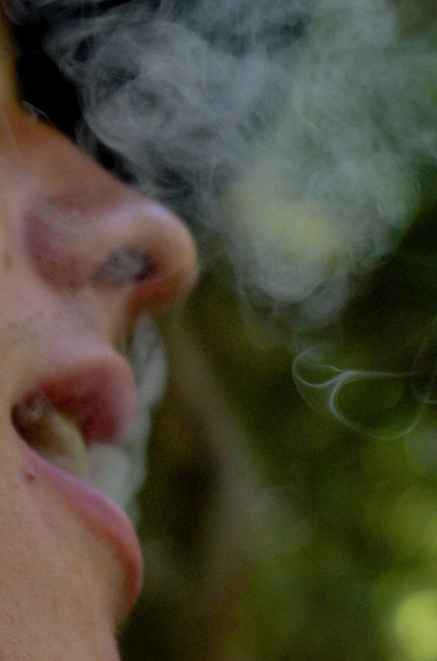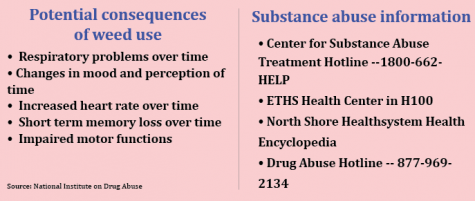The Pot Thickens
November 3, 2017
While the Evanstonian and ETHS do not condone the use of marijuana, the legalization and use of weed has grown to be a highly contested topic, and recreational marijuana use has become more common (and legal in some cases) among students and citizens. With a resolution in the state legislature and a growing population of weed smokers in Evanston, we take a look at the pros and cons of legalization, the reasons why certain students smoke weed and the ways in which marijuana can affect users.
Marijuana legislation stagnates in Illinois
$700 million.
That’s how much revenue the legalization of marijuana could bring to the state of Illinois, as suggested by legislators searching to clear the rubble in the aftermath of the state’s budget crisis.
State Sen. Heather Stean and state Rep. Kelly Cassidy of Edgewater have set forward a bill proposing legalization of weed in Illinois. Cities like Chicago and Evanston set a precedent for this policy after moves to lighten penalties on marijuana possession in the past decade. Evanston decriminalized the drug in 2011 with an ordinance championed by Evanston city council members, including second ward alderman Peter Braithwaite.
With enough support the legalization bill could find its place tacked on to the next budget passed by the state in June of next year. The current budget passed in July after two full years of Illinois not having a spending plan. Over those two years Illinois added $15 billion to its considerable debt profile, and the current budget can only cover $8 billion of that deficit, assuming the best of circumstances. Proponents argue that several-hundred million dollars in additional tax revenue annually is a big step forward in amending this issue.
This deficit has caused major problems for Illinois schools. Though ETHS rests behind the strong buffer of high-property taxes, CPS schools with no such advantage have faced devastating cuts and underfunding. Nevertheless all Illinois schools stand to benefit from a clearing of the state’s debt.
Evanston residents and politicians have advocated for similar legislation in recent years, which led to decriminalization in 2011, but only the state has the power to fully legalize the drug. It’s become apparent that in the short term the federal government is not interested in legalizing marijuana and the responsibility will be on states. No legislation aimed towards cannabis legalization has gained any political traction since the advent of the short-lived CARERS act of 2014 which failed to pass the senate.
“I think it’s absurd that marijuana is still illegal in Evanston,” says one anonymous Evanston student. “Lightening penalties isn’t enough.” Another student claimed that they “support [marijuana]’s current decriminalized status, it’s certainly not an offense worth facing prison, but it’s not a behavior we should be encouraging.”
In the short term marijuana remains illegal, with exceptions for medical prescriptions. For further change Evanston residents will have to look to Springfield and Rauner for the future of marijuana policy. Whether that be moving its status to that of a legal commodity, increasing penalties, or lightening punishments.
Stress causes marijuana usage
Although marijuana can be damaging to their health, some students overlook the risks and smoke weed anyway, reporting that they enjoy the simplicity and bliss that comes with it.
“The one thing I love about weed is that it’s like a temporary vacation, everything is different when you’re high,” a sophomore boy says. “I don’t stress, I don’t even think about stressful shit. Everything’s easier when you’re high, everything’s better when you’re high.”
Overwhelmed by AP classes, homework assignments, or other stressors involving family or friends, students are often in search of something to relieve their stress and boost their mood. Some students say the effects of marijuana work to do just so.
“It makes everything seem a little hazy almost as if you were in a dream,” a senior girl explains. “It makes me funnier, and more confident.”
A sophomore boy says, “smoking weed is euphoric, you feel like you’re in this constant state of just simplicity.”
The feeling of haziness and euphoria students speak of is caused by a chemical called THC, the main psychoactive component of marijuana. The National Institute on Drug Abuse reports “THC activates the brain’s reward system, which includes regions that govern the response to healthy pleasurable behaviors, like sex and eating.” It also stimulates a flood of dopamine, which contributes to the high.
This process varies based on the method of intoxication. When smoked, the body absorbs THC right away, whereas the consumption of an edible has a less immediate effect on the user’s body.
“I don’t think smoking is a big deal for people who are educated about it,” one senior boy says. “If someone is going to smoke without knowing what’s going to happen to them, then maybe they shouldn’t do it.”
Health teacher Montell Wilburn acknowledges the negative effects of marijuana, such as increased heart rate, a risk of lung cancer, decreased motivation, and memory loss. While he doesn’t support marijuana usage, he lets his students make their own decision about whether or not to use it.
“I never tell my students to not do drugs or to do drugs,” Wilburn says. “I educate them on the facts, and hopefully they can make an educated choice if they decide to use the drug or not.”
Wilburn knows that many students smoke marijuana, and believes it’s because “they’re easily influenced. They see others doing it and they want to. It’s a part of our culture, it’s in our music…. If students didn’t see it all around them they wouldn’t do it.”
Though the vast majority of students don’t come to school high, there are some students who do.
One senior girl says, “I come to school high probably like three to five days a week.”
To many, smoking frequently during the school year is not a big deal. Students may smoke before school or during their lunch period.
“I do one or the other, it really depends on the amount of work I have.”
Other students are aware of this behavior. “If someone were to tell me they were high during school, I wouldn’t be surprised.” Says one senior boy.
Most decide not to use marijuana during school hours because they find it interferes with their schoolwork.
“Occasionally I come to school high, but it’s something I try not to do very often because it has some effect on my focus. It’s sort of like your head’s in the clouds; it’s just a little harder for you to think clearly. I think it sometimes makes me care less and makes me less motivated. For the most part I don’t associate getting high with working, I usually save it for my free time so I can enjoy it more.”
Students are generally taught about the science and consequences of weed rather than firsthand experiences of being high.
As Wilburn believes, stories about marijuana can help students make an educated decision to use the drug or not. Students too believe that there is no better, more powerful informative source on weed than firsthand experience. For some, the love of weed outweighs all of its consequences. But whether for fun, to relieve stress, or to be part of a distinct culture at ETHS, all agree that marijuana should only be used with proper awareness of its effects.
Teens seek marijuana for medical purposes
No one ever died of a marijuana overdose.
Though controversy surrounding legalization remains, more teens are beginning to seek marijuana for medical purposes.
“As the owner of a mental health clinic, I have seen a range of patients benefit from the use of medical marijuana,” Ph.D Ari Goldstein says.
Weed has been proven to ease symptoms of medical conditions, but not all teens who undergo physical pain or mental trauma can get their hands on medical marijuana.
In Illinois, qualifications for applying to get a medical marijuana card include being 18, being diagnosed with a qualifying condition, having a physician’s consent, and having proof of residency.
Despite the current stigma, marijuana usage actually dates back all the way to 2737 B.C. and made it’s way to America in the 1540’s. In fact, it was published in the United States Pharmacopeia from 1850 until 1942.
Studies have proven that marijuana is effective in helping a variety of diseases. It has not only helped to soothe tremors and pain in Parkinson’s patients, but was actually found to slow the progression of these diseases.
Asthma, Epilepsy, HIV/AIDs and Alzheimer’s disease are just a few more examples of conditions whose symptoms have been eased with cannabis.
According to the National Academies Press, the cannabinoids in marijuana block peripheral nerves that detect pain, ultimately causing pain relief.
“I have a chronic pain condition mostly surrounding my back, it’s something I’m aware of everyday,” an anonymous junior says. “I’m still not entirely sure why I am in the pain I’m in. I currently have a prescription for a CBD concentrate, I take it on bad days and it really helps.”
CBD stands for cannabidiol. A concentrate is essentially any method in which the oil has been separated from the actual plant.
Marijuana among teens is also widely used to ease mental trauma. According to Teen Mental Health, 1 in 5 teens suffer from a mental disorder.
With this increasing prevalence of mental illnesses among teens, it’s no wonder why marijuana usage among adolescents is on the rise again.
“Patients diagnosed with PTSD often find that it reduces their symptoms of anxiety,” Goldstein says. It helps them sleep, reduces flashbacks, and allows them to live much more ‘normal’ lives.”
“It’s the cartridges of THC oil that are most helpful to me,” one anonymous senior says. “It’s helping me manage panic attacks and flashbacks. For years I got several a day, and after a year of using them I can say I almost don’t have any at all. It’s simply the best medicine that has ever helped me.”
This senior is currently in the process of obtaining a medical marijuana card.
According to Goldstein, cannabis can also help with severe anxiety and depression symptoms.
“Certain cannabis strains can be used to elevate the mood, while others can be used to induce a calm, tranquil effect,” he says.
An anonymous junior who struggles with anxiety agrees.
“It helps my anxiety a lot in ways like helping me fall asleep at night and makes me have a better attitude and look on the situation,” the junior said.
She is not yet eligible for obtaining a medical marijuana card, but is interested in eventually applying for one.
For more information on the benefits of marijuana, visit www.arstechnica.com.













A. Suri • Nov 11, 2017 at 9:58 am
Nice survey, but…I have a few questions that may deserve a follow uo study
1. Do students who were high during class finally get better grades? Do they achieve higher level of learning experience or just zoning out due to boredom and lack of motivation to learn?
2. In a followup study – how successful in life were these “high” students ? Did they get into higher learning institutions of their choice? Did they become successful in life despite dropping out and were able to attribute their success to cannabis or the inspirations they get from being high in school.
3. facts about smoking anything should be stressed – we already know the long term effects of cigarette smoking. Cannabis smoking may be more or less harmful – we don’t know.
As a residence of Illinois -I have thought that the taxation of marijuana sales would help alleviate the current deficits but our politicians seem to be oblivious to the heavy debt the citizen is facing.
Thank you for the article and the neutral study .
Thank you